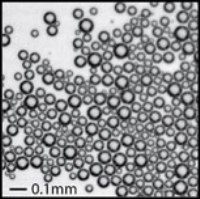Liquid foams fascinate toddlers singing in a bubble bath. Physicists, too, have an interest in their acoustical properties. Borrowing from both porous material and foam science, Juliette Pierre from the Paris Diderot University, Paris, France and her colleagues studied liquid foams. They used an impedance tube to measure the velocity and attenuation of acoustic waves in liquid foams in a broad frequency range.
The study published in EPJ E is a first in the literature. It could help in assessing any liquid foam’s bubble size or in designing the optimal foam structure for sound proofing.
 LiquidFoams EPJE © J.Pierre et al.
LiquidFoams EPJE © J.Pierre et al.
The authors used well-characterised liquid foam samples. Thus, they knew all the parameters needed for computing predictions on the acoustics characteristics of existing foam models.
The authors found that the effective velocity of sound in liquid foams is low, ranging from 20 to 60 meters per second. It is lower than the speed of sound in each of its constituents, namely 1,500 and 340 meters per second in water and air, respectively. They also confirmed previous findings: sound velocity only depends on the liquid volume fraction and not on the bubble size over the investigated range of frequencies.
In addition, by looking into several types of liquid foams with the same structure but different composition, they found shaving foam to have a higher effective sound velocity than any other foam. This means that the type of foaming solution influences acoustic properties.
Finally, they showed that the existing models do not give a good prediction of the high sound attenuation observed. The next step would be to understand the influence of the distribution of bubble size and the physicochemical composition of the foam.
References:
J. Pierre et al.(2013), Acoustic characterisation of liquid foams with an impedance tube, European Physical Journal E, 36: 113, DOI 10.1140/epje/i2013-13113-1
The full-text article is available to journalists on request.
Source: http://www.springer.com/